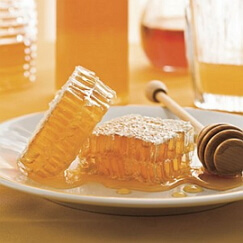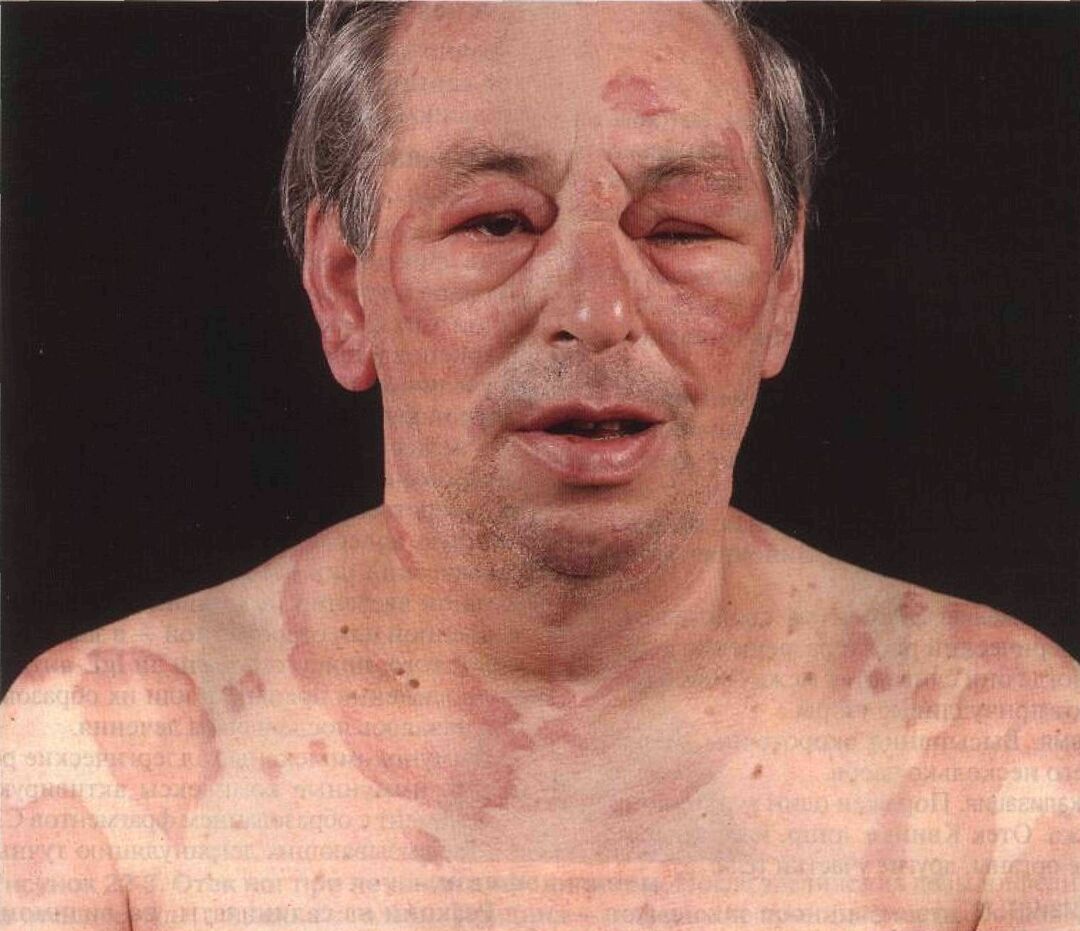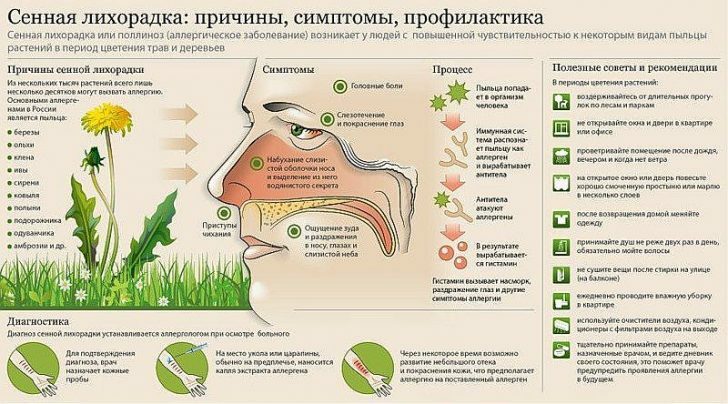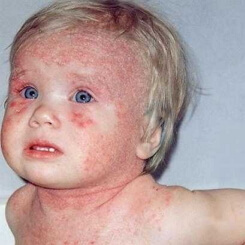Allergy to honey
 Allergy to honey - an allergic reaction of the body to pollen of plants, contained in this product. If honey does not go through the full process, it always has a residual amount of pollen from the plants visited by the bees. It is the pollen that is the provoking allergen, since the main composition of honey is simple sugars, which can not cause an allergic reaction.
Allergy to honey - an allergic reaction of the body to pollen of plants, contained in this product. If honey does not go through the full process, it always has a residual amount of pollen from the plants visited by the bees. It is the pollen that is the provoking allergen, since the main composition of honey is simple sugars, which can not cause an allergic reaction.
Most people believe that an allergy to honey - a fairly common phenomenon and it is strictly not recommended to give to young children. So, this is not so. Allergy to honey in children is observed very rarely, not more than usual sugar. In the vast majority of cases, an allergic reaction is manifested after eating falsified honey, which can contain both cane( allergenic) sugar and various medicinal substances, sometimes used for the treatment of bees. In addition, poorly processed honey contains pollen of plants pollinated by bees. It is pollen allergy, which is quite common, and is the main cause of allergy to honey. Biological and chemical contamination, which can cause an allergic reaction, get into the honey very rarely, and that because of inexperience or bad faith, the beekeeper, who does not comply with the terms and norms for carrying out the treatments, abuses various top dressings and does not control the purity in the apiary.
An important role in the development of this disease is heredity, so the allergy to honey can easily develop in a child whose blood relatives already have the disease. Moreover, the allergic reaction in each person manifests itself individually, for example, a person can not use honey, but the products with the addition of honey use without problems. This is due to the fact that the allergic reaction to honey develops only on its specific varieties.
Separately, I would like to note that often beekeepers use certain antibiotics in their hives to increase the activity of bee colonies in spring. In this case, an allergy develops to antibiotics, not to honey itself, which is simply an intermediary of the transmitted allergen.
Often, this type of allergy occurs in asthmatics and people suffering from allergic rhinitis. According to the researchers, this is due to a decrease in immune defense, various disorders in the gastrointestinal tract and general slagging of the body.
There is a fairly common alternative opinion that allergies to pollen, and in particular to honey, do not exist in nature at all, and the established opinion about the allergic properties of honey is erroneous due to the use of a falsified product based on ordinary sugar, which is in itselfSufficiently strong allergen. During processing sugar is subjected to a sufficiently strong heating, which leads to the release of a very strong carcinogen - oxymethylfurfural, which causes this allergic reaction. To exclude such a situation, you should get honey from a well-known real beekeepers.
Allergy to honey - symptoms
Symptoms of this disease manifest almost instantly and are characterized by unpleasant sensations in the mouth, throat swelling and swelling. It is because of the rapid manifestation of symptoms, many allergists recommend before using a new grade of honey, put a very small amount of it on the tongue and wait a bit. In case of appearance of the above-described symptoms, immediately rinse the oral cavity with water.
Another method of testing honey for allergenicity is to apply a small amount of it to the inner fold of the hand. If in a short period of time different skin reactions begin to manifest in the form of hives, swelling and itching - this product is contraindicated. The allergic reaction of the body to honey develops regardless of sex and age.
The main symptoms of honey allergy are: swelling of the mucous membrane of the lips, tongue and throat, swelling of the nasal mucosa and runny nose, swelling in the throat and mouth, coughing, swelling of the nasal mucosa, sneezing, runny nose, skin rashes, nausea, severe itching of the skin, Fever, headache, increased fatigue
Allergy to honey - treatment
As with all other diseases of an allergic nature, treatment of allergies to honey is primarily based on complete rejection of an allergic reaction product, as well as beverages and products containing it. If the allergic reaction is already in full swing, an antihistamine should be taken without delay to relieve acute symptoms. If the symptoms of honey allergy after taking an antihistamine drug continue to be observed, you should not hesitate to consult the allergist
for a long time. Treatment with honey
In addition to the fact that honey is rare enough, but still capable of causing an allergic reaction, it is a wonderful remedy for allergies, With the most effective is honeycomb. To get rid of hay fever, sinusitis and runny nose, you just need to chew a small amount of it.
Young children, even infants, honey often cures exudative diathesis. At kids the annoying itch and dryness of a skin disappears, on a head there pass seborrheic crusts, reddening and an ecdysis of cheeks disappears. However, it should be remembered that before giving the baby honey, it is necessary to make a sample for sensitivity to this product. According to the results of long-term observations, it was established that children, who since childhood use honey in reasonable quantities, are developing mentally and physically much faster than their peers.
If the child is aroused, moody and often crying, he has insomnia, nighttime urination, and sleep is restless and superficial - to reduce or even completely disappear the listed symptoms should regularly take 1 tsp. Honey in the morning and evening, without interrupting the course of up to a half and more months. However, it should be closely monitored so as not to miss the possible( in rare cases) development of an allergy to honey. In two weeks, improvement will be noticeable. If necessary, the treatment with honey can be repeated after a month's break.
The second, no less important property of honey is antibacterial. Immediately after the appearance of the child's first signs of rhinitis( runny nose), it should be diluted 1: 1 with boiled water and brew the resulting solution into the nose. If the child is more than six months, a small amount of propolis aqueous solution can be added to this solution. Directly the aqueous propolis solution itself can be used without diluting after a year and a half. If the rhinitis has already passed into the chronic stage, the following composition will help: ½ st. Spoons of honey + ½ st. Spoons of water r-propolis + 6 cap. Tincture of eucalyptus oil + 10 ml of tea brewing. This mixture should be( first clearing it) to dig in your nose, at least six times a day. Store the resulting mixture in a refrigerator, without refreezing.



